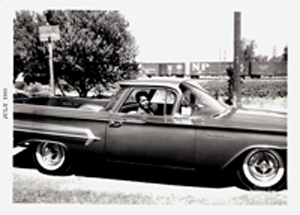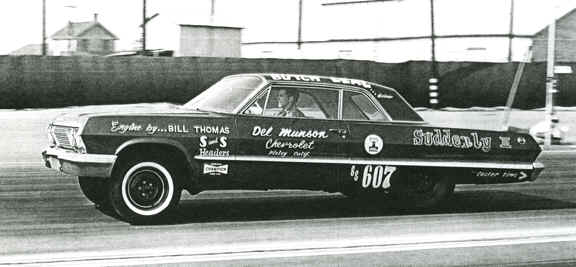Click on images to see larger view
The Super Stock Years....
In the beginning....
Tulare is a farming community in the San Joaquin Valley of central California. Basically your quiet little town typical of so many others in the 40's. Life is laid back. Larry Leal was born and Tulare had no idea things were about to change. My grandmother saw it the first time she saw me.
"he's not a Larry.... he's a Butch".
That was the first indication that things were about to get a little more lively around the area.
I grew up in Tipton and Pixley, not far from Tulare. I was fascinated by cars and when he was twelve years old, my mother got me a subscription to Hot Rod Magazine. I would look at the cars in the magazine and take some ideas and incorporate them into designing my next model car. It would take me five or six model kits to get the parts I needed to build one car. Once I got that one built, I would start all over and build another one of my fantasy cars.
When I was fourteen, I decided that I needed a real car to build. I traded my Mustang motor scooter for a '46 Ford and then I traded the '46 Ford for a '31 Model A but I kept the tires and wheels. Once the wheels and tires were agreed to the deal was made. In the surrounding fields, there were a lot of old abandoned or wrecked cars. I knew most of the farmers in the area and talked to several about letting me take parts off of them. I soon had four motors, a lot of transmission parts and all of the other parts needed to start building a car. Once I had the frame put together and a running motor, I got four men to help lift the body back in place. In a very short amount of time I was driving the car and tuning on it and got the thing to where it would run 60 mph. When I got pulled over in the car for a "fix it" ticket, the officer asked to see my driver's license. Sure enough I didn't have one.... I was still just fourteen. Dad and I went to court. Since I drove trucks in the fields loading hay, my Dad asked the judge for an agricultural driver's license and the judge granted it.
When I was sixteen I worked all summer long for my fathers trucking business loading hay. My dad and I struck a deal that if I worked that summer without pay, he would buy me a new car. My choice was a 1960 El Camino that had a 348, three deuces, four speed, painted royal blue and was slammed two inches off the ground. This thing would run! It didn't take long for me to slip off to Famosa Drag Strip and try my hand at racing on a real track. When I got home, I asked my folks if I could start racing the truck and they promptly told me "NO".... That is when I pulled the trophy from behind my back and told them I had entered my very first race and won it. This was the beginning of my racing career. Not long after this first race, I discovered H.L. Shahan's shop in Tulare. This was the beginning of a long racing relationship between the two of us.
Now all I wanted to do was race.
I continued racing my 1960 El Camino. In Bakersfield, a racer with a 1961 Impala beat me. My parents told me, “ Butch, if you want to do this, do it right.” So I sacrificed the best looking street truck around to “do it right.”
I went to H.L. Shahans shop and the El Camino's engine was pulled out and balanced, the carburetors re-jetted, headers added, the suspension was raised and they installed Halibrand wheels with street tires. I continued to win races, gathering up 3 trophies per race for class, eliminator and the club’s choice. Although I was not an established local racer yet, around the area I was being called the “teenage phenomena.”
In 1962 I ordered a new 409 Chevrolet Biscayne with 2-4’s. The car was delivered in Pixley and I drove it 13 miles to Shahans shop in Tulare. Within two weeks the car was race ready but I told H.L. “we need to talk to Don Nicholson”. So off to Pasadena, Ca. we went to Nicholson’s shop. Don told me what rear end ratio we needed. I bought the parts and my first race was at Hanford Ca. where we floated the valves running 108 mph. 200 lbs of traction weight was added to the car and I ran 13.30 at 108 mph winning the race.
When I was still in high school I would cut classes and go to H.L.'s. I told H.L we needed to change rear end gears to a 4.56 ratio because NHRA rules stated “no slicks” and we had to run on street tires. The next race was in Fresno, Ca. where the car ran 13.00 at 111 mph and I won the race.
I was reading Drag News (before National Dragster was in print) and read about M&H's 7” tires. I bought a pair of the tires and headed to Vacaville where a lot of well known racers raced on Saturday nights. When we pulled into Vacaville, Al Vander Woude “The Flying Dutchman” had just run 12.80 at 112 mph. The race car was unhooked from the tow bar and my first run was 13.00 at 111 mph. I looked at my parents and said “we need to leave the line harder.” Immediately the new M & H tires were bolted on. In those days you could choose who you wanted to race first. I chose “The Flying Dutchman”, the number 1 qualifier. Letting the clutch out on the burn out, the 409’s engine bogged but once off the line it ran 12.76 at 113 mph which was a new track record and I won the race. My car was protested by the track operators (which was not an NHRA track) because they thought we had two of the 409 single four barrel carburetors on the engine, which were larger than the dual four barrel carbs. They weren’t able to justify their protest so the win stood.
On Sunday the decision was made to go to Lodi (an NHRA track) to race. At the track, I asked tech if you could port match the heads with the intake manifold. They said no, it was against the rules but they allow port matched heads and manifold at the Fremont track. It was 11am and time was running out. We drove at over 100 mph as we headed to Fremont (which was 80 miles away) and was at the track by noon. The racers were waiting for me because we had raced Vacaville the night before and everyone usually raced at Fremont on Sunday. The tech officials checked my car over and said “Oh, you changed carburetors last night.” I hadn’t, but if they thought we had and it meant we could race, then that was all that mattered. H.L. told me to go out and take it easy. I didn’t have easy in me. I ran 12.68 at 114 mph. After that weekend the rules changed making port matched heads illegal.
There was a guy in Delano that had a street 409 Impala. I tracked him down asked if we could trade heads and manifold because I needed stock parts to be legal. We traded parts and the Delano car ran quicker and I was once again legal. I milled the heads, bolted the motor back together and went to the Inyokern points race which was located in the high desert. Don Nicholson set the record at 13.01 but I ran 13 flat and won the race. At this race, Bernie Partridge protested me and that night the car was torn down at Bernie’s house. Jack Hart and Bill "Farmer" Dismuke checked the engine and it was legal. Les Ritchie later told me that if we went to Pomona we might run 12.50’s.
We went to Pomona, which was a weekly race, and all the famous west coast names were there. I was running 12.67 and a Dodge was running 12.62. When it came down to the final round I had to run the Dodge of Bill "Maverick" Golden. Bill Westbrook (another racer) told me he wanted us to run his tires against the Maverick. They were Castlers (recaps). The tires were bolted on and the car ran 12.55 at 114 mph winning the race. From that time on I was never outrun on the West coast. We raced at Pomona every weekend, winning and outrunning the factory cars.
This is when I first met Bill Thomas.
Continued in part two...
Part 1 | Part 2 | Part 3 | Part 4 | For the Record
|
|

